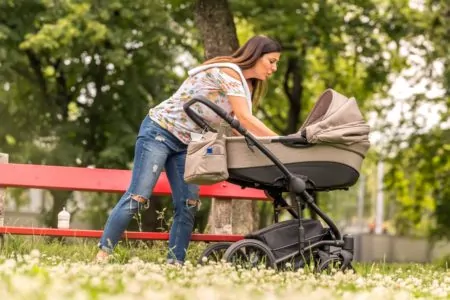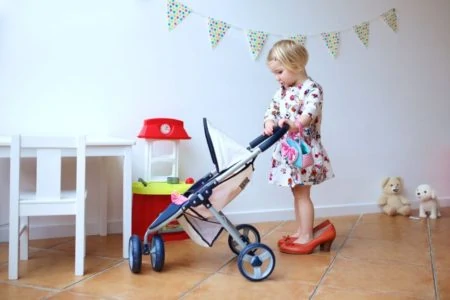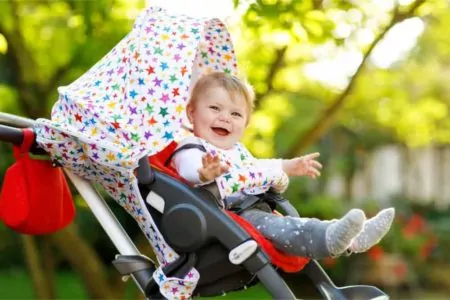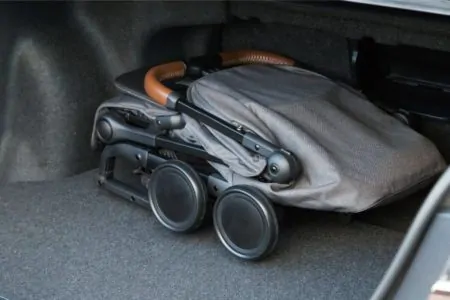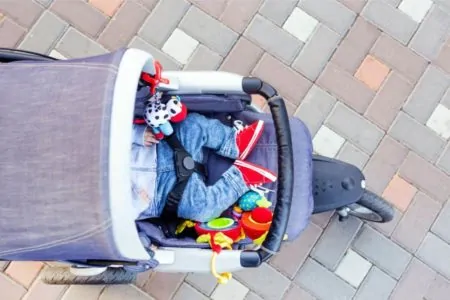Were you aware that, in 2016, there were 10,000 stroller-related injuries treated in the emergency room (1)? Strollers are essential for nearly all parents who plan to stay mobile postpartum. But not every parent knows of the potential dangers a baby could face while sitting in these vehicles.
The best way to avoid a preventable injury is to be informed about stroller safety. If you’re feeling overwhelmed, perhaps even worried you’ll do something wrong, you’re not alone.
First, let’s discuss what type of stroller is safe based on a baby’s age. Until an infant has enough core muscle strength to sit upright, a reclinable stroller is best. With this type of stroller, you baby will lie flat, similar to how he or she rests in a bassinet or crib. After six to seven months old, most infants are able to tolerate sitting inclined in a stroller (2). A younger infant may fall forward and out of this type of stroller.
Key Takeaways
- Choose a reclinable stroller for babies under six months, and always use a five-point harness for safety.
- Pick a stroller with a wide base, easy-to-use brakes, and secure storage baskets located away from rear wheels.
- Ensure leg openings are snug for infants, and avoid side-by-side double strollers with individual footrests.
- Always stay close to the stroller, avoid direct sunlight, and check for recalls to keep your baby safe.
Stroller Safety Tips
When expecting your first child, there’s a lot to remember — you may already have a six-page checklist. Purchasing a stroller is likely to be on there somewhere, so here are some safety tips to remember when buying and using one:
1. Brakes
You wouldn’t park a car without its brakes on, and the same should apply to your stroller. It’s highly recommended to engage them whenever you stop or idle.
The best brakes to go for are those consisting of locking mechanisms within the wheels rather than ones that use pressure (3). When buying, try them out — they should be easy to operate, even while wearing flip-flops.
We also recommend brakes that lock two wheels as opposed to one. This will provide extra security.
Another thing to watch out for is where the brake lever sits. Poorly-designed strollers may have one sitting in the front where an older child can reach. Verify that it’s out of range for your child.
2. Seat Belt and Harness
Seat belts and harnesses are crucial features to have in your stroller, and you should always use them. Babies wiggle and move. Even newborns can slip out when not restrained correctly.
The best seat belt to use is a five-point harness. These restrain your baby in crucial places — over the shoulders, across the waist, and between the legs. If your infant requires extra support, roll up small baby blankets and use them as bumpers. Once your infant is able to roll from a back to belly position, these bumpers should be removed.
3. Go Wide on the Base
A sturdy stroller is imperative. Some of today’s more “trendy” buggies have slim bases, decreasing stability. A broad base will ensure the optimal balance, and reduce the chances of tipping the stroller.
4. Location of Storage Basket
An onboard storage basket is fantastic for carry-on luggage — you can use them for your diaper bag, gear, or even shopping. But some baskets can become unsafe to load due to their location. Avoid strollers with a storage area resting over the rear wheels.
Look for a basket that sits low, toward the back, but in front of the rear wheels. This will prevent it from tipping the stroller when loaded.
Always Use The Storage
5. Mind the Twin-Footrest
If you’re buying a double side-by-side stroller, avoid those with individual footrests. The gap between them can trap one of your baby’s feet, causing an injury. Go for a single footrest that spans the full width of the stroller (5).
6. Snug Leg Openings
If you’re using a stroller for an infant, ensure they can’t slip through the leg openings. This has sadly been a cause of strangulation — the gaps are usually large enough for a body, but not a baby’s head (6). To avoid this risk, verify that the openings are snug or have a way to close them entirely.
Remember to always use the seat belt in your stroller to help your baby stay safely in place, and never leave him or her unattended while in the stroller.
7. Easy Steering
Not all buggies are easy to steer — some require constant correcting. A swivel-or-lock function is a great feature to look for when buying.
The swivel function makes most strollers easy to turn, even with one hand. When you need more stability, use the lock function.
To test the steering, try pushing the stroller in a straight line using one hand. If it swerves to the side, look for another model.
8. Stability
When you’re looking for a stroller, check for stability. Inspect the wheel-base and ensure that it’s broad. Then check that the seat sits low inside the frame.
If you’re in doubt, put some of your weight on the handles. It should resist tipping backward, indicating a stable frame and wheels.
How to Keep Your Baby Safe
Keeping your baby safe while in the stroller involves more than strapping them in. Here are ways to make sure your little one is protected:
1. Don’t Exceed Weight Limits
Strollers don’t have an age limit — instead, they use weight. This is because infants of the same age can have completely different weights. Exceeding the limit can make the buggy unstable.
It’s also essential to verify the weight limit if you’re using a stroller board — an attachment for older toddlers. These are not for use with older kids — most have a limit of 50 to 55 pounds.
2. Stroller Board Safety
If you’re using a stroller board or a stand-on platform, tell your child to stay still. Sudden movements, jumping, or other motions can impact the steering and stability of the buggy.
3. Always Stay Close
Never leave the stroller unattended with your baby inside. It can roll away, get too hot, or your little one could slip out and get trapped. Always stay close enough to hear and see your baby.
4. Fasten Toys
My little one hated the stroller; the toys hanging from the bumper bar were the only reason he stayed put. However, it’s vital to fasten them securely, so they don’t get loosen and fall on your baby.
Shorter length fasteners are preferred in order to prevent an accidental strangulation.
You can test this by tugging on them. If toys come loose with little force, the chances are they present a safety hazard.
5. Avoid Direct Sunlight
When parking, try to find some shade. If you’re parking for a while, take into account the movement of the sun.
Your stroller might have a sun canopy, but it can still get steaming hot underneath. Metal and plastic parts can become scorching, potentially burning you or your baby.
Another thing to avoid is placing a blanket over the sun canopy to cover your baby at the front. By doing this, you’re preventing ventilation and increasing the chances of overheating.
6. Be Careful When Folding
Take caution when folding the stroller, and keep your child at a distance. Small fingers get pinched in the hinges.
7. Verify It’s Fully Unfolded
It happens that strollers spontaneously collapse when not fully unfolded (7). This is another potential safety hazard. Make sure you read the instructions on how to fold and unfold.
Many of today’s buggies make a clicking sound to indicate when they are fully unfolded and safe to use. Before placing your baby inside, give it a good shake to verify it won’t collapse.
8. Watch Out for Recalls
Look out for recalls — these happen when several injuries or hazards are reported about a product. Examples include detaching wheels, collapsing frames, faulty seat belts, failing brakes, and risk of entrapment (8). The Consumer Protection Safety Committee regularly reports recalled products (9). This is a reliable source to review before purchasing a stroller.
After purchasing your stroller, it’s good to register it with the manufacturer. This way, you’ll receive first hand notifications of recalls.
When Can You Use a Stroller?
You can use a stroller from the first day, but it must provide the correct support for an infant. The buggy should have a sturdy frame and good suspension to minimize jostling, as well as have a fully reclining seat.
For your newborn, there are three types you can choose between — travel system, stroller frame, and bassinet attachment. If you’re going to get around a significant amount by car, a travel system or stroller frame is best.
Travel systems are all-in-one bundles. You get a stroller, infant car seat, and a base for your vehicle. A stroller frame is only the chassis, and requires you to purchase a separate, compatible infant car seat.
If you don’t travel much by car, or not at all, opt for a buggy allowing for bassinet attachments. This way, your baby can lie completely flat and receive the needed support.
Steer away from umbrella strollers for now. This type doesn’t allow for a fully reclining seat, meaning it won’t be safe for your baby.
Once your baby can support their neck and sit up (usually around 6 months), less caution is required. Now you can use your stroller without a bassinet or infant car seat.
Sleeping Babies and Strollers
Letting your baby nap in the stroller while out and about isn’t a safety concern as long as you take precautions. For infants, ensure they lie fully reclined, so their necks remain supported. If they’re in a car seat, you can use special inserts or rolled up blankets to keep them from slumping over.
Older babies should remain in the harness. Seal off the leg openings if possible to prevent them from slipping out. Avoid large blankets, and never cover their faces.
Keep It Rolling
Knowing about stroller safety is imperative to avoid injuries and accidents while out and about with baby. Look for a stable frame, wide base, optimal brakes, and smooth steering. Avoid overloading the buggy, and never leave it unattended while your baby is inside.
You will love having adventures with your baby as they see the world from their stroller. And, the best part is that you can have confidence they’ll be safe.
